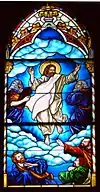Exorcism of the Gerasene demoniac
The exorcism of the Gerasene demoniac, frequently known as the Miracle of the (Gadarene) Swine and the exorcism of Legion, is one of the miracles performed by Jesus according to the New Testament.[1] The story shows Jesus exorcising a demon or demons out of a man and into a herd of swine, causing the swine to run down a hill into a lake and drown themselves.
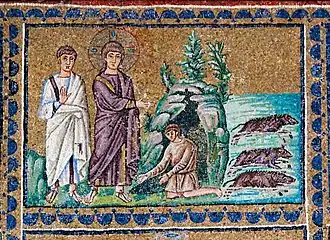
The story appears in the three Synoptic Gospels, but not the Gospel of John. All accounts involve Jesus exorcising demons, identified collectively in Mark and Luke as "Legion".
The story was interpreted by Saints Augustine of Hippo and Thomas Aquinas to mean that Christians have no duties to animals.[2] It has been a point of contention in discussions of Christianity and animal rights.[3]
Narratives
Mark
The earliest account is from the Gospel of Mark (Mark 5:1–20), in which Jesus goes across the sea into the "region of the Gerasenes".[4] There, a man "possessed by a demon" comes from the caves to meet him. People had tried to tie him down but he was too strong to be bound, even with chains for he would always break out of them; night and day among the tombs and in the hills he would cry out and cut himself with stones. Jesus approaches and calls the demon to come out of the man, who replies "What do you want with me, Jesus, Son of the Most High God? I beg you in the name of God never to torment me!" Jesus asks the demon for his name and is told "My name is Legion, for we are many". The demons beg Jesus not to send them away, but instead to send them into the pigs on a nearby hillside, which he does. The herd, about two thousand in number, rush down the steep bank into the sea and are drowned. The man is now seen, dressed and restored to sanity: he asks to be included among the disciples who travel with Jesus, but he is refused and instructed to remain in the Decapolis region, to tell of "the great things the Lord has done ... and [how he] has had compassion on you". Theologian Tom Wright calls him "the first apostle to the gentiles".[5]
Matthew
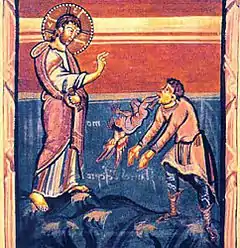
The author of the Matthew Gospel shortens the story more dramatically (Matthew 8:28–34) and writes not of one possessed man, but of two.[6] In this version, Jesus does not ask for the demon's name – an important element of traditional exorcism practice.[7]
The location is also changed to the region of the "Gadarenes" (Gadara) as in most Bible translations. The King James Version in (Matthew 8:28) has the location as "Gergesenes" which corresponds to the modern "Kursi" (Kheras), the most plausible location of the Gospel event.
Luke
The Lucan gospel version (Luke 8:26–39) shortened this but retained most of the details.[6] One detail that the Lucan gospel has but the other gospel writers lack is a reference to both the demoniac’s nakedness and his subsequent clothing. At Luke 8:27, the gospel writer notes that the demoniac wore no clothes. Then he notes that he “was clothed and in his own mind” (Luke 8:35). Clothing is an important prop in the Lucan narrative (see Biblical clothing), which in this scene portrays the demoniac’s development from his animal-like state to his restoration as a human being. Initially the possessed man has been expelled from the human race—that is, he is no better off than an animal without clothing—but, after his exorcism, his humanity is fully restored and he rejoins the human race, “clothed and in his right mind” (Luke 8:35).
Commentary
Gerasa, Gadara, or Gergesa?
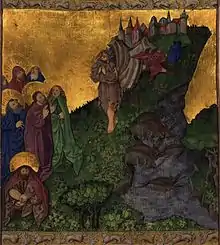
The story appears to be set close to the Sea of Galilee, but neither Gadara nor Gerasa is nearby; both cities are southeast of the lake, Gadara 10 km away or a three-hour walking distance, and Gerasa well over twice as far. Origen speculated that there had been a town called "Gergasa" on the shores of the Sea.[8]
The differing geographical references to Gadara and Gerasa can be understood in light of the social, economic, and political influence each city exerted over the region. In this light, Matthew identified the exorcism with the local center of power, Gadara, located about ten kilometres southeast of Sea of Galilee, whereas Mark identified the event with the regional center of power, Gerasa, located further inland.[9] The city of Gerasa had been a major urban center since its founding and during the Roman period it was the more widely known among the ten-city league known as the Decapolis.
As to the candidate for the location of the Gospel event, the most common consensus is that the miracle to took place near the town of Gergesa, the modern Kursi, close by the eastern shore of the Sea of Galilee, and therefore in the country of Gergesenes.
Naming, and use of singular and plural
The revealing of the demon's name has parallels with other examples in Jewish exorcism lore in the Second Temple period.[10]
Historical and biblical context
It has been widely accepted by scholars that several motifs throughout the account refer to the Roman legion. Further possible echoes include Isaiah 65:4 with parallels to both graves and swine:[11]
- "A people who ... sit among the graves, and spend the night in the tombs;
- Who eat swine's flesh, and the broth of abominable things is in their vessel".
Animal rights
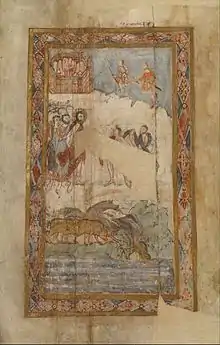
Classical theological commentary cited this story to argue that animals have no moral importance in Christianity.[12] Saint Augustine of Hippo concluded from the story that Christians have no duties towards animals,[2] writing:
Christ himself shows that to refrain from the killing of animals and the destroying of plants is the height of superstition, for judging that there are no common rights between us and the beasts and trees, he sent the devils into a herd of swine and with a curse withered the tree on which he found no fruit.[13]
Similarly, Thomas Aquinas argued that Jesus allowed the demons to destroy the pigs in order to make the point that his purpose was primarily for the good of men's souls, not their bodies or property (including their animals).[3] This interpretation has been shared by a long line of commentators up to the present day, including I. Howard Marshall and Mark Driscoll.[3] However, other commentators have attempted to make the story consistent with a Jesus who shows "care and concern for animals," as John Austin Baker wrote.[13][3] Such alternative readings include arguments that the swine were meant to represent the Roman army or "unclean and unfaithful" people; that pigs were considered "unclean", so destroying them might be consistent with care for other animals; and that Jesus did not actually "send" the devils into the pigs. He merely allowed the demons to go where they themselves chose to go.[3][12][13]
Rene Girard's Scapegoat Theory
This episode plays a key role in the literary critic Rene Girard's theory of the Scapegoat.[14] In his analysis, the opposition of the entire city to the one man possessed by demons is the typical template for a scapegoat. Girard notes that, in the demoniac's self-mutilation, he seems to imitate the stoning that the local villagers would likely have attempted to use against him to cast him out of their society, while the villagers themselves show by their reaction to Jesus that they are not primarily concerned with the good of the man possessed by demons:
"Notice the mimetic character of this behavior. As if he is trying to avoid being expelled and stoned in reality, the possessed brings about his own expulsion and stoning; he provides a spectacular mime of all the stages of punishment that Middle Eastern societies inflict on criminals whom they consider completely defiled and irredeemable. First, the man is hunted, then stoned, and finally he is killed; this is why the possessed lived among the tombs. The Gerasenes must have had some understanding of why they are reproached or they would not respond as they do. Their mitigated violence is an ineffective protest. Their answer is: 'No, we do not want to stone you because we want to keep you near us. No ostracism hangs over you.' Unfortunately, like anyone who feels wrongfully yet feasibly accused, the Gerasenes protest violently, they protest their good faith with violence, thereby reinforcing the terror of the possessed. Proof of their awareness of their own contradiction lies in the fact that the chains are never strong enough to convince their victim of their good intentions toward him."[14]
On Girard's account, then, the uneasy truce that the Gaderenes and the demonic had worked out was that the evil power in him was contained and thereby neutralized. Jesus' arrival on the scene introduced a spiritual power stronger than Legion, which upset the societal balance by removing the scapegoat. This reversal of the scapegoat mechanism by Jesus is central to Girard's entire reading of Christianity, and this reversal is on display in this story as well. Contrasting the self-destruction of the herd of pigs with the typical motif of an individual evildoer being pushed over a cliff by an undifferentiated mob (cf. Luke 4:29), Girard comments:
"But in these cases it is not the scapegoat who goes over the cliff, neither is it a single victim nor a small number of victims, but a whole crowd of demons, two thousand swine possessed by demons. Normal relationships are reversed. The crowd should remain on top of the cliff and the victim fall over; instead, in this case, the crowd plunges and the victim is saved. The miracle of Gerasa reverses the universal schema of violence fundamental to all societies of the world."[14]
Proverbial use
The story is the origin of the English proverbial adjective Gadarene, meaning "involving or engaged in a headlong or potentially disastrous rush to do something".[15]
References
- The Life and Ministry of Jesus: The Gospels by Douglas Redford 2007 ISBN 0-7847-1900-4 page 168
- Honderich, T. (2005). The Oxford Companion to Philosophy. Oxford Companions. p. 37. ISBN 978-0-19-926479-7.
- Spalde, Annika; Strindlund, Pelle (2012). "Doesn't Jesus Treat Animals as Property?". In York, T.; Alexis-Baker, A.; Bekoff, M.; McLaren, B. (eds.). A Faith Embracing All Creatures: Addressing Commonly Asked Questions about Christian Care for Animals. Peaceable Kingdom Series. Wipf & Stock Publishers. p. 102. ISBN 978-1-61097-701-2.
- Other textual variations include "Gadarenes" and "Gergesenes".
- Wright, T., Mark for Everyone, 2001, p. 57
- Donald Senior, What are They Saying about Matthew? (Paulist Press, 1996) page 84.
- Craig S. Keener, A Commentary on the Gospel of Matthew (Wm. B. Eerdmans Publishing, 1999) page 282.
- M. Eugene Boring, Mark: A Commentary (Presbyterian Publishing Corp, 2006) pages 148–149.
- McArthur, Dr. John (1987). Matthew 8–15. MacArthur New Testament Commentary. The Moody Bible Institute of Chicago. p. 41. ISBN 0-8024-0763-3.
- R. Barthes, F. Bovon, F. J. Leenhardt Structural Analysis and Biblical Exegesis: Interpretational Essays 1974 -0915138026 "To force him to surrender his name is to make him more vulnerable to the grasp of the exorcist. Now the name that the demon surrenders to Jesus is a collective singular: "Legion is my name", --- (5:9). This name (although in the singular) is a multiplying term."
- Brown, Raymond E. et al., The Jerome Biblical Commentary, Englewood Cliffs, New Jersey: Prentice–Hall Inc., 1968, p. 32.
- Preece, R.; Chamberlain, L. (2010). Animal Welfare and Human Values. Wilfrid Laurier University Press. p. 16. ISBN 978-1-55458-767-4.
- Linzey, A. (2016). Christianity and the Rights of Animals. Wipf & Stock Publishers. p. 48. ISBN 978-1-4982-9195-8.
- Girard, Rene (1986). The Scapegoat. Baltimore, MD: The Johns Hopkins University Press. pp. 165-183. ISBN 9788534948203.
- The Oxford Dictionary of Phrase and Fable, 2006
External links
 Media related to Evil spirits sent into swine at Wikimedia Commons
Media related to Evil spirits sent into swine at Wikimedia Commons

